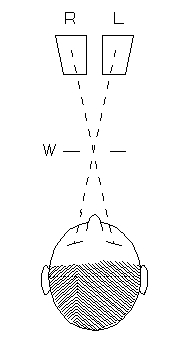
Stereos from outer space.
This page requires a monitor width of at least 1000 pixels in order to see both images for cross-eyed stereo viewing. Since the photos also have large vertical dimension, it sometimes helps to toggle the "full screen" view (F11 in Windows). However, if you haven't mastered the cross-view method, these pictures may also be appreciated as 2D flat photos.For instructions on free-viewing 3d by the cross eyed method, see the How to View 3D page.
Astronomical stereo photos.
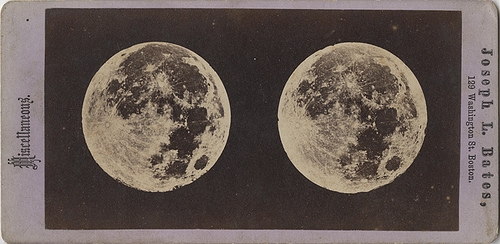 |
In the very early days of photography Henry Draper, a chemist from New York University, made the first daguerrotype portrait in the USA in 1840. He also made stereo photos of the moon with a reflecting telescope. These were reproduced later on Victorian era "stereo view cards". How was it done? The moon keeps the same face toward earth throughout its orbit, but it wobbles on its own axis. So it shows a little more than half of its surface to us if we are patient and observe it at the extremes of its wobble. This is just enough stereo parallax so that pictures taken of the moon at these extremes make a good 3d photo showing the true roundness of the moon.
The viewcard above is for parallel-axis viewing. The images are reversed left-right as an astronomical telescope sees it. The stereo below is more recent (displayed for cross-axis viewing), and presented as the eyes would see it. The very bright crater with equally bright "rays" radiating from it is prominent in both pictures.

The Lunar Reconnaissance Orbiter (LRO), provided high resolution images that NASA stitched together to prodce a high resolution virtual Moon rotation movie. (September 16, 2013.) You can view it here Rotating Moon. You can even grab still frames from this movie to produce 3d views like this one. You will recognize familiar features from the near side as well as some from the far side.
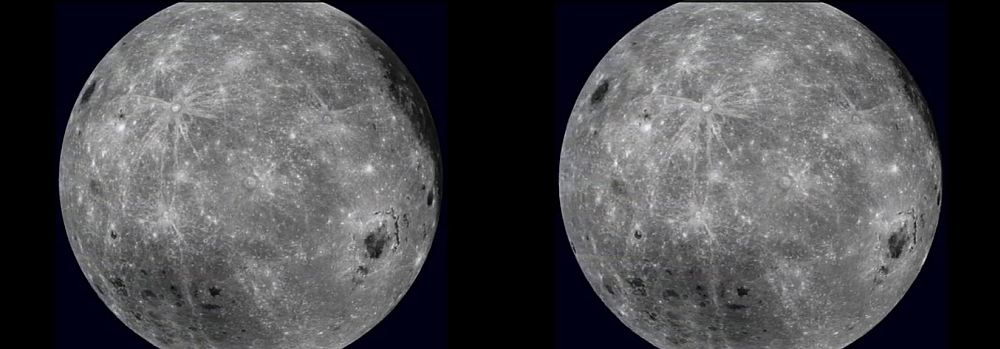
Recently [December 2012], NASA released an animation of the rotating earth. It was a composite of photographs taken from the international space station. Apparently NASA did not take the obvious next step of taking successive frames from this movie as left and right eye pairs, and presenting them for stereo viewing. So I had to do it.

And here's the other side of the earth.

Saturn, taken by the Hubble Telescope in 2004, at two seasons. NASA.
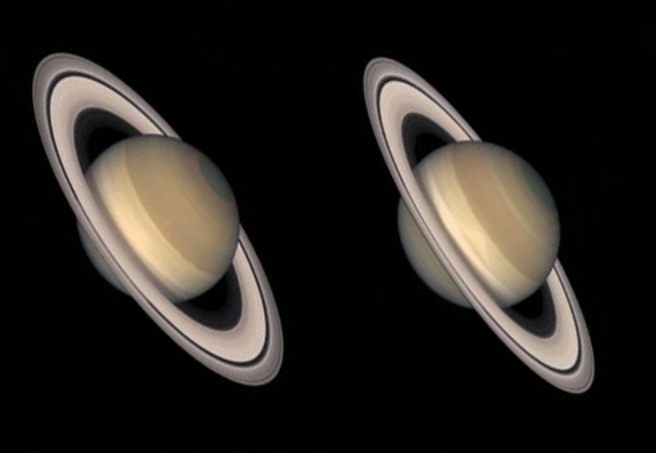
In 1969 the Apollo ll manned moon mission carried several cameras, including a specially designed Hasselblad 2.25 inch square format camera with grid lines superimposed on the pictures. This much-publicized picture was taken in stereo. The astronauts were not very good at judging appropriate shift for good stereo.

One camera that got very little publicity was the Apollo Lunar Surface Close-Up Camera designed for photographing 3 x 3 inch portions of the lunar surface on 35mm film. This camera was the project of astronomer Thomas Gold who had been promoting the idea that the lunar surface was a deep layer of dust. He had even been quoted in the press as warning that astronauts would be in danger of sinking into that dust if they set foot on the moon. Gold told me later that he'd been misquoted. He based his concerns on radar data from the lunar surface. The lunar dust did indeed have a "crust" a few mm thick which was porous, the "sand castle effect", which accounted for the radar data. NASA had been cool to the idea of this camera, calling it contemptuously the "Gold camera". But Gold had some "pull" that succeeded in getting it included in the mission. The astronauts did take a few pictures with the Hasselblad camera and "cha-cha" methods, and some of these were released commercially on view-master reels.
The camera was designed by Kodak, and used frames 7 perf. wide on 35mm film. I'm guessing the interocular was about 1.5 inches. It was fixed focus and fixed distance, on the end of a walking cane, to be pressed down on the ground and an internal flash illuminated the surface for the picture. Only three 36 exposure rolls of film were shot with this camera. These stereo pictures are online, and are quite boring. Though made with color film, the results seem nearly monochrome.
Here's a picture of that camera on the Lunar surface, taken with the Hasselblad custom camera, cha-cha.
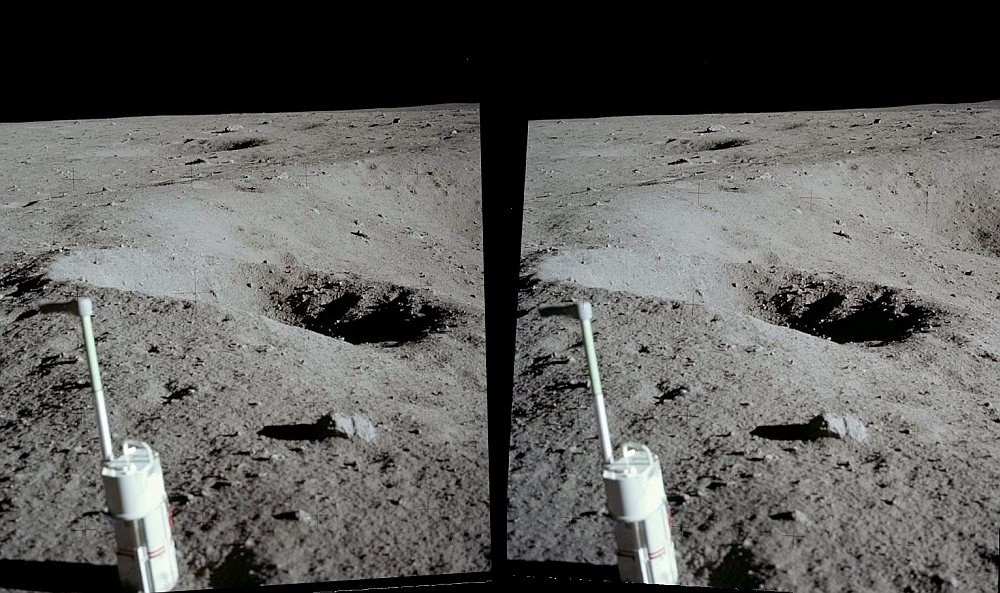
Here's one of the pictures taken with that camera.
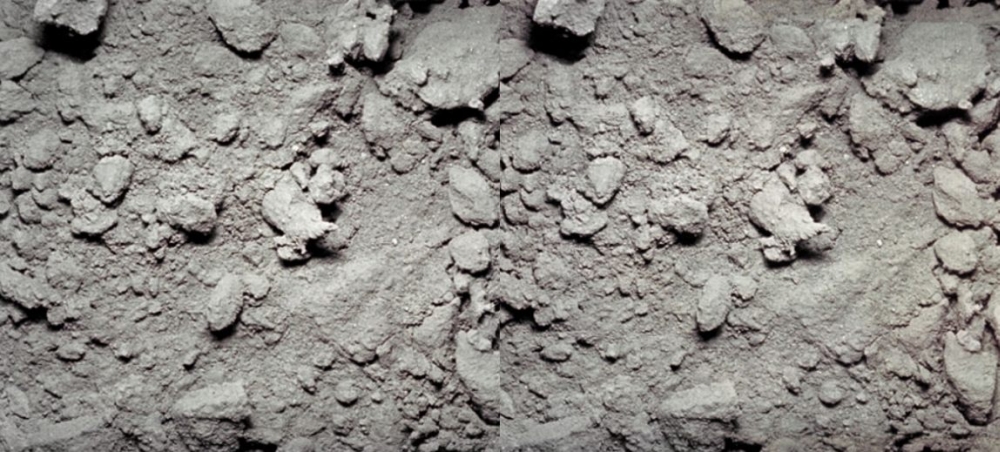
NASA space probes are equipped with dual cameras that can produce stereo pictures. Their interlens spacing is often much larger than the human eyes. Here's an example from 2012 during the Curiosity mission, of the surface of mars. Isn't it curous how most of these rocks have their pointy ends upward, rather than a flat surface? The Martians must have arranged them that way.
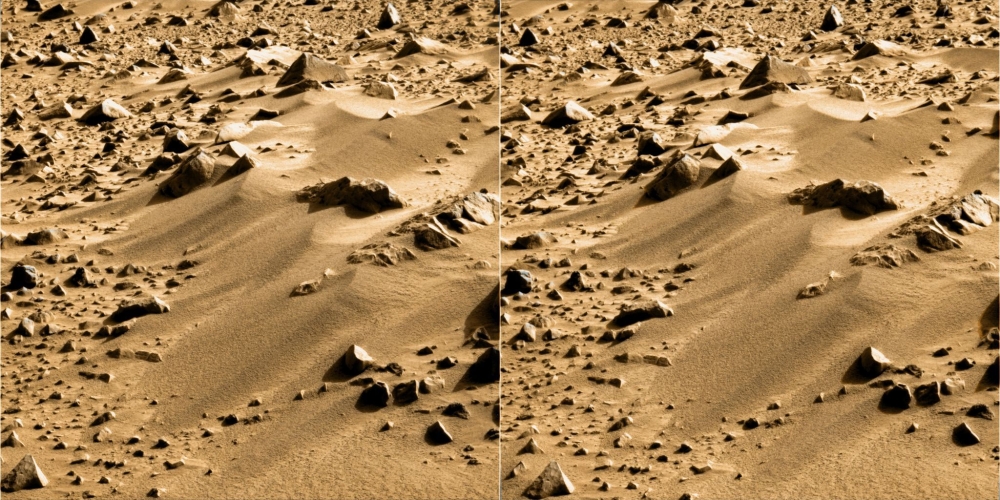
Comets move rather rapidly across the starry background, so two photos of a comet taken a day or two apart show distinct parallax between the comet and the distant stars. This stereo of Morehouse's comet was taken on Nov. 16, 1908.

This stereo of Halley's comet was taken by John Wattie in April, 1986.
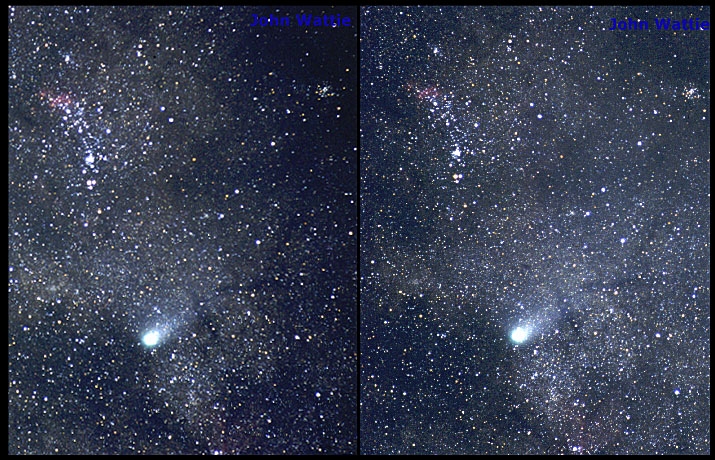
In 2014, the European Space Agency's Rosetta spacecraft chased the comet 67P/Churyumov–Gerasimenko and took this stereo picture of it.
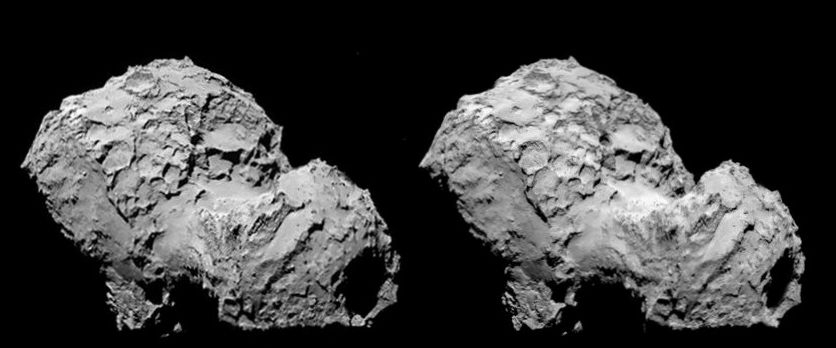
Stereo pictures for cross-eyed viewing 3d Gallery One.
More cross-eyed stereos in 3d Gallery Two.
Stereo view cards in 3d Gallery Three.
Building a digital stereo close-up photography system in 3d Gallery Four.
Review of the Loreo stereo attachment 3d Gallery Five.
Review of the Loreo macro adapter, 3d Gallery Five B
The Loreo macro stereo attachment—improved 3d Gallery Five C.
The Loreo LIAC attachment as a 3d macro device, 3d Gallery Five D.
Wildlife photography in your backyard, 3d Gallery Six.
A home-built digital stereo camera using mirrors 3d Gallery Seven.
Stereo close-up photography in your garden 3d Gallery Eight.
Stereo photography in your aquarium 3d Gallery Nine.
Stereo digital infrared photography 3d Gallery Ten.
Wider angle stereo with the Loreo LIAC 3d Gallery ll. A failed experiment.
Review of the Fuji FinePix Real 3D W1 camera. 3d Gallery 12.
Macro attachment for the Fuji FinePix REAL 3D W1 camera. 3d gallery 13.
Panoramic stereo photography. 3d Gallery 14.
Tips for stereo photography with the Fuji 3d camera. 3d Gallery 15.
Mirror methods for stereo photography. 3d gallery 16.
The Fuji 3d macro adapter using mirrors, by Paul Turvill.
The Fuji 3d macro adapter with flash! 3d gallery 17.
Critters in stereo. 3d gallery 18
Wide angle stereo. 3d gallery 19.
Telephoto Stereo. 3d gallery 20.
2d to 3d Conversions. 3d gallery 21.
Stereos From Outer Space. 3d gallery 22.
Review of the Panasonic Lumix 3d digital camera. 3d gallery 23.
Reverberant flash for shadowless lighting.
Digital stereo photography tricks and effects.
Shifty methods for taking stereo pictures.
Stereoscopy with two synchronized cameras by Mike Andrus.
Guidelines for Stereo Composition.
Return to the the 3d and illusions page.
Return to Donald Simanek's front page.